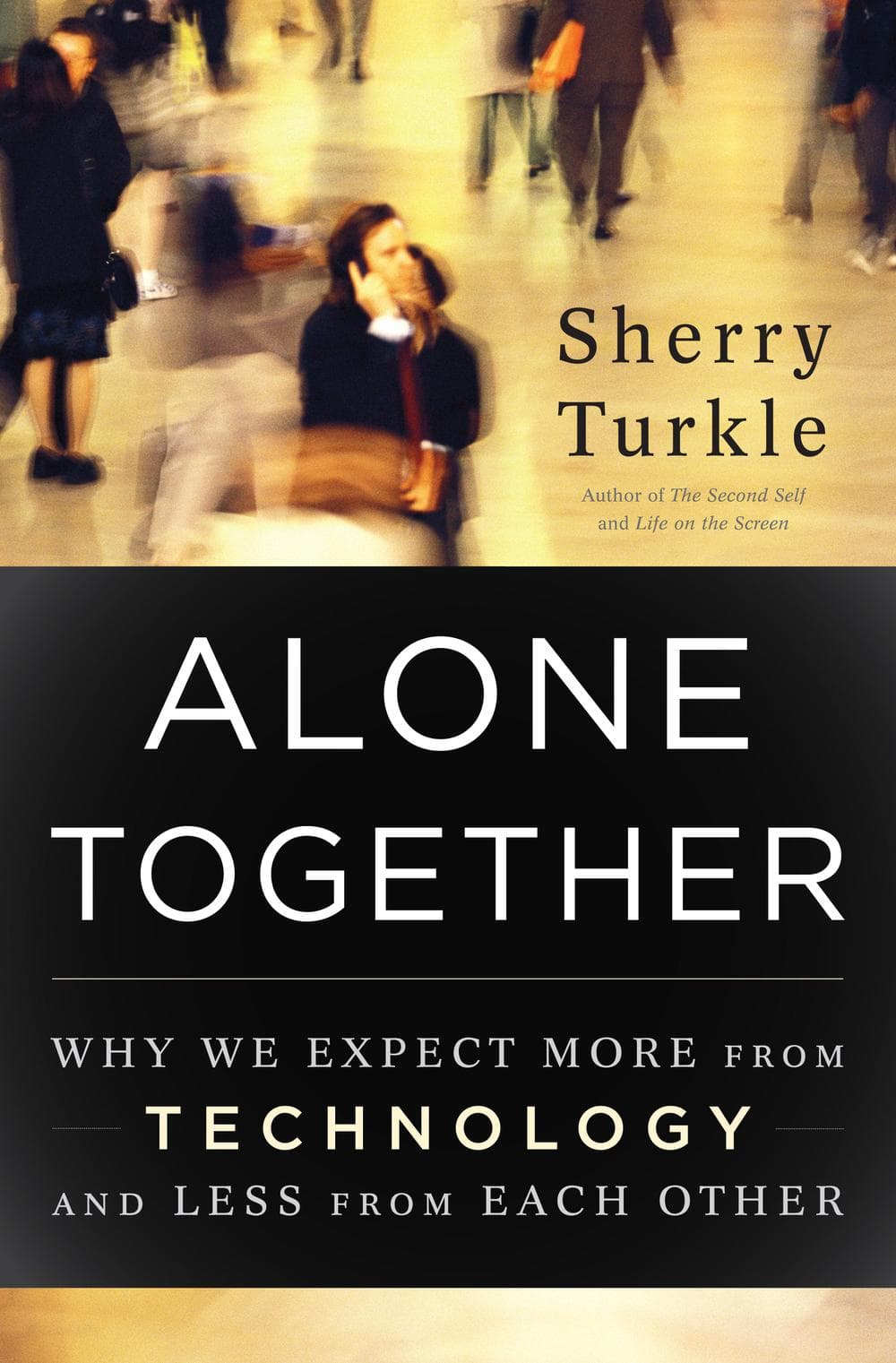Advertisement
MIT Professor Calls For Facing The True Costs Of Technology
Resume
Sherry Turkle is no Luddite. She founded and directs the MIT Initiative on Technology and Self and was an early enthusiast for new interactive technologies.
But she started having second thoughts after watching children and the elderly play with robots. She saw that they were easily fooled into believing that robots cared for them, and she argues that in the same way, we are now seduced to believe that online interactions are real relationships.
Turkle believes that technology is diminishing our humanity, but she's also optimistic about finding a way to put the social networks and smart phones in their proper place.
Sherry Turkle's new book is, "Alone Together: Why We Expect More From Technology and Less From Each Other," excerpted below.
Alone Together: Why We Expect More From Technology and Less From Each Other
By Sherry Turkle
Technology proposes itself as the architect of our intimacies. These days, it suggests substitutions that put the real on the run. The advertising for Second Life, a virtual world where you get to build an avatar, a house, a family, and a social life, basically says, “Finally, a place to love your body, love your friends, and love your life.”1 On Second Life, a lot of people, as represented by their avatars, are richer than they are in first life and a lot younger, thinner, and better dressed. And we are smitten with the idea of sociable robots, which most people first meet in the guise of artificial pets. Zhu Zhu pet hamsters, the “it” toy of the 2009–2010 holiday season, are presented as “better” than any real pet could be. We are told they are lovable and responsive, don’t require cleanup, and will never die.
 Technology is seductive when what it offers meets our human vulnerabilities. And as it turns out, we are very vulnerable indeed. We are lonely but fearful of intimacy. Digital connections and the sociable robot may offer the illusion of companionship without the demands of friendship. Our networked life allows us to hide from each other, even as we are tethered to each other. We’d rather text than talk. A simple story makes this last point, told in her own words by a harried mother in her late forties: I needed to find a new nanny. When I interview nannies, I like to go to where they live, so that I can see them in their environment, not just in mine. So, I made an appointment to interview Ronnie, who had applied for the job. I show up at her apartment and her housemate answers the door. She is a young woman, around twenty-one, texting on her Black- Berry. Her thumbs are bandaged. I look at them, pained at the tiny thumb splints, and I try to be sympathetic. “That must hurt.” But she just shrugs. She explains that she is still able to text. I tell her I am here to speak with Ronnie; this is her job interview. Could she please knock on Ronnie’s bedroom door? The girl with the bandaged thumbs looks surprised. “Oh no,” she says, “I would never do that. That would be intrusive. I’ll text her.” And so she sent a text message to Ronnie, no more than fifteen feet away. This book, which completes a trilogy on computers and people, asks how we got to this place and whether we are content to be here. In The Second Self, I traced the subjective side of personal computers—not what computers do for us but what they do to us, to our ways of thinking about ourselves, our relationships, our sense of being human. From the start, people used interactive and reactive computers to reflect on the self and think about the difference between machines and people. Were intelligent machines alive? If not, why not? In my studies I found that children were most likely to see this new category of object, the computational object, as “sort of ” alive—a story that has continued to evolve. In Life on the Screen, my focus shifted from how people see computers to how they forge new identities in online spaces. In Alone
Technology is seductive when what it offers meets our human vulnerabilities. And as it turns out, we are very vulnerable indeed. We are lonely but fearful of intimacy. Digital connections and the sociable robot may offer the illusion of companionship without the demands of friendship. Our networked life allows us to hide from each other, even as we are tethered to each other. We’d rather text than talk. A simple story makes this last point, told in her own words by a harried mother in her late forties: I needed to find a new nanny. When I interview nannies, I like to go to where they live, so that I can see them in their environment, not just in mine. So, I made an appointment to interview Ronnie, who had applied for the job. I show up at her apartment and her housemate answers the door. She is a young woman, around twenty-one, texting on her Black- Berry. Her thumbs are bandaged. I look at them, pained at the tiny thumb splints, and I try to be sympathetic. “That must hurt.” But she just shrugs. She explains that she is still able to text. I tell her I am here to speak with Ronnie; this is her job interview. Could she please knock on Ronnie’s bedroom door? The girl with the bandaged thumbs looks surprised. “Oh no,” she says, “I would never do that. That would be intrusive. I’ll text her.” And so she sent a text message to Ronnie, no more than fifteen feet away. This book, which completes a trilogy on computers and people, asks how we got to this place and whether we are content to be here. In The Second Self, I traced the subjective side of personal computers—not what computers do for us but what they do to us, to our ways of thinking about ourselves, our relationships, our sense of being human. From the start, people used interactive and reactive computers to reflect on the self and think about the difference between machines and people. Were intelligent machines alive? If not, why not? In my studies I found that children were most likely to see this new category of object, the computational object, as “sort of ” alive—a story that has continued to evolve. In Life on the Screen, my focus shifted from how people see computers to how they forge new identities in online spaces. In AloneTogether, I show how technology has taken both of these stories to a new level. Computers no longer wait for humans to project meaning onto them. Now, sociable robots meet our gaze, speak to us, and learn to recognize us. They ask us to take care of them; in response, we imagine that they might care for us in return. Indeed, among the most talked about robotic designs are in the area of care and companionship. In summer 2010, there are enthusiastic reports in the New York Times and the Wall Street Journal on robotic teachers, companions, and therapists. And Microsoft demonstrates a virtual human, Milo, that recognizes the people it interacts with and whose personality is sculpted by them. Tellingly, in the video that introduces Milo to the public, a young man begins by playing games with Milo in a virtual garden; by the end of the demonstration, things have heated up—he confides in Milo after being told off
by his parents.

We are challenged to ask what such things augur. Some people are looking for robots to clean rugs and help with the laundry. Others hope for a mechanical bride. As sociable robots propose themselves as substitutes for people, new networked devices offer us machine-mediated relationships with each other, another kind of substitution. We romance the robot and become inseparable from our smartphones. As this happens, we remake ourselves and our relationships with each other through our new intimacy with machines. People talk about Web access on their BlackBerries as “the place for hope” in life, the place where loneliness can be defeated. A woman in her late sixties describes her new iPhone: “It’s like having a little Times Square in my pocketbook. All lights. All the people I could meet.” People are lonely. The network is seductive. But if we are always on, we may deny ourselves the rewards of solitude.
Copyright © 2010 by Sherry Turkle
This segment aired on January 14, 2011.